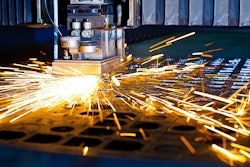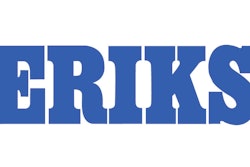INDUSTRIAL DISTRIBUTION:
Enhancing the M&A Experience
The highly fragmented
industrial distribution
sector has emerged
as a prime target
for mergers and
acquisitions (M&A)
in recent years for
a number of
diverse, yet very
attractive reasons.
Presented by:
Sponsored by:
2Industrial Distribution: Enhancing the M&A Experience
The highly fragmented industrial distribution sector has emerged as a prime target for mergers and acquisitions (M&A) in recent years for a number of diverse, yet very attractive reasons.Investment experts cite the sector’s strong performance and durability through downturns. Industrial distributors are also able to destock inventory and squeeze
the balance sheet when necessary in order to generate a healthy cash flow. State-of-
the-art technology and a lack of import competition also make the sector attractive.In essence, industrial distribution provides investors and acquir-ers with several pathways to growth returns on invested capital —whether organically or through acquisition—that may not be as evident in many of the nation’s manufacturing, service, and technology sectors. The majority of middle market industrial distributors are closely held or family owned businesses—some for many generations—
and serve highly focused niche markets, maintaining long-stand-ing reliable relationships with suppliers and customers alike. Often, most of the family wealth is centered within the business itself.When looking to obtain new sources of capital, many owners consider monetizing the value that they’ve created in their companies, but feel they are not yet ready to give up operating their businesses. In such cases, investment bankers say there are several possible options. With available private equity capital today far surpassing investment opportunities in industrial distribution, one approach might be to “sell off” an equity stake to an investor group without “selling” them-selves out of the business itself. In other words, giving
up financial control of the company while still maintain-ing operational responsibility and a meaningful equity stake in the company.
INTRODUCTION
Industrial distribution
provides investors and
acquirers with several
pathways to growth
returns on invested
capital.
3Private equity firms find the upside potential, limited downside risk, and generally stable industrial distribution environment to be a particularly attractive M&A in-
vestment path. Operating as a “partner” to the operator, these firms can help identify new strategic opportunities and accelerate growth, while giving owners the oppor-tunity to diversify their personal wealth without relinquishing operational oversight and upside through their minority ownership established by “rolling over” proceeds
on a tax-free basis.That said, bringing the parties together and orchestrating a successful M&A trans-action requires a sizable investment in time, focus and energy by the seller, who still
must keep the day-to-day business on track. The buyer, meanwhile, needs to fully un-derstand not only the industry but also the many subtleties of the particular product distribution market.
Sellers often engage the advisory services of investment banking firms, such as KeyBanc Capital Markets, which can help identify potential private equity investors while serving as an intermediary between buyer and seller, analyzing the many com-
plex factors along the way. An investment banking firm can facilitate due diligence efforts, and create an overall positive, less stressful M&A experience for the seller while creating competitive tension among the buyer universe.In this white paper, we’ll take a close look at the M&A process in industrial distribu-tion, the objectives of the seller, private equity buyer and investment banker, as well as many of the key considerations on all sides. We’ll also look at the importance for the seller to effectively articulate the company story and vision, the amount of back-
ground work involved, and why, when handled correctly, it can be a win-win-win.
It’s safe to say that private independent business owners usually are deeply involved
in the day-to-day operations, often working for several years with a lean, but trusted, dedicated and talented executive staff, but not always having the time to consider new strategic initiatives.In some cases, de-pending upon owner
age or lack of a long-term succession plan for the business, the owner may be inter-ested in accessing capital that is invest-ed in the business through sale of an eq-uity stake. They may also be interested in continuing to run the
SELLING WITHOUT SELLING
Industrial Distribution: Enhancing the M&A Experience
4Industrial Distribution: Enhancing the M&A Experience
business operations, while ensuring new long-term strategic initiatives to benefit the company and its employees.Although there’s a long list of alternatives that one may consider, the choices es-sentially fall into four major buckets, according to T.J. Monico, Head of Industrial
Distribution Investment Banking at KeyBanc Capital Markets, the full-service,
middle-market investment banking division of KeyCorp. Monico offers the following options: 1. Do nothing and stay on track with the business as is
2. Seek a minority equity or subordinated debt investment
3. Partner with a financial investor (e.g. private equity firm, family office, other)
via sale of a financial controlling interest, i.e., 50+ percent
4. Sell 100 percent of the business to a strategic or financial party
Diversifying WealthMonico said that from an equity investor’s perspective, the most attractive invest-
ment option is No. 3, whereby the owner sells a financial controlling interest but maintains a minority investment and operational involvement in the business, refer-ring to it as “selling without selling.” Depending upon the size of the deal, the own-ership structure, and the stage in the owner’s lifecycle, post transaction the owner
typically retains somewhere between 5 and 49 percent and in many
cases still maintains responsibility for day-to-day operations.“As a result, typically owners can receive a very strong valuation multiple for the business relative to selling a minority stake, so it gives them a chance to diver-sify their personal wealth, the majority of which is typically their investment in the business,” Monico
explained. “They align with a qualified investor who functions more as partner, not an operator interested in running the business.”In such cases the private equity investor serves more as a sounding board in a group that can help accelerate growth, identify other opportunities for improvement,
such as refining pricing strategies, warehouse automation
or configuration concepts, and provide advice should the busi-ness management team need it. “What that means is when that group decides to sell the business, typically the own-
ers make a significantly greater amount of money from that second bite of the apple than they do in the initial transaction,” he said.Private equity investor Jonathan Pressnell, principal at Blue Point Capital Partners,
agreed that management, financial and market advice are key components of a pri-
vate equity firm’s partnerships with industrial distributors and others.
“I would classify us as active board members,” Pressnell said. “We want to know what’s going on in the business, we want to be involved in the key strategic decisions,
but in terms of day-to-day management we are not involved in that. There are certain areas (China, M&A & data analysis) where we think we can be particularly helpful.”“A lot of the times the CEOs will reach out to us to get guidance and get our perspec-tive on things, but we’re not dictating to them how they should be spending their time,” Pressnell added. “We do have operating partners that we use to provide some of the operational insights and again those are not folks that are looking to be full time CEOs.”Rather, he said, they are looking to take a more consultative approach. But, he em-phasized that Blue Point looks primarily for investments where they ultimately have
more than a 50-percent stake in the business. Just as option No. 3 is popular with most private equity investors, it also tends to be the preferred choice by private owners of industrial distribution businesses.
Maximizing Benefit, Minimizing RiskThe private equity capital invested typically goes into owner’s pockets, unless the investor is just providing an equity commitment in exchange for ownership, but not giving liquidity to the owner, which is far less common.
The real benefit to owners is the availability of a strong capital base behind them, helping structure the distributor’s balance sheet without
over-levering the company in such a way as to prohibit in-vesting in growth. In other words, investing in technology or expanding the company footprint after a private equity deal should not impair the company’s balance sheet.
Industrial Distribution: Enhancing the M&A Experience
The real benefit to owners
is the availability of a strong
capital base behind them,
helping structure the distrib-
utor’s balance sheet without
over-levering the company
in such a way as to prohibit
investing in growth.
5
6The other major benefit is to minimize the risk to the business and its owner, espe-cially when initiating more aggressive acquisition or consolidation strategies. Acting alone, the owner, whose majority of wealth might be invested in the business, poten-tially is putting all of that investment on the line, adding an element of risk to both owner and business.On the other hand, when taking on a private equity partner, while giving up a share
of equity, the owner reduces the risk and amount “on the line,” but can still benefit from an upswing aided by the partner’s experience in helping companies identify and evaluate acquisitions and other growth initiatives.
Other Choices
Option No. 4, selling 100 percent of the business, generally is more common among owners intent on running their businesses until they’re ready to walk away, accord-ing to Monico.“Regardless of where performance is, they reach a point where they know how much money they want to retire with, they’re done with some of the headaches of running a business independently, and they decide to sell,” he said. “In some cases those owners stay on as part of a larger organization for a period of time, in other cases they don’t.”
With all of the considerations, decisions and potential challenges that take place during typical M&A discussions, especially while the owner involved still has a successful business to run, the investment banker plays a pivotal advisory role in the process, working closely with the seller.
Full-service investment
banking firms like KeyBanc Capital Markets also actively work with strategic buyers
and private equity firms by introducing them to potential acquisition targets and help-
ing finance deals.“We get intimately involved in the discussions with the sellers, which is not always easy at times considering the different emotions involved,” according to Monico. “We have a lot on the line also as advisors, committing substan-
Industrial Distribution: Enhancing the M&A Experience
INVESTMENT BANKERS:
ADVISING SELLERS, FINDING BUYERS
7Industrial Distribution: Enhancing the M&A Experience
tial time and highly educated resources to every transaction, so there’s a lot at stake for all parties involved. It’s also why it’s important for us to properly communicate the potential valuation the company might receive to that business owner.”
“If final bids aren’t up to the expectations, and the owner decides not to sell, it means the company, the buyers and advisors spent meaningful resources for a long period of time without a successful outcome to show for it,” the investment banker pointed out.It’s also critical during the M&A process not to lose sight of what’s most important, which is running the business and avoiding the added pressure of having business valuations reduced along the way, a major factor in deals that fail to close.
Preparing for the Equity Sale To be successful in closing an M&A deal, company executives should be prepared to clearly communicate their value proposition to potential private equity investors, including how they are executing on their business plan and what gives them a leg up on the competition. “It sounds simple but the management team needs to proper-ly articulate why they add value to the supply chain and the customer base, and why customers choose them,” Monico said.
“Similarly, having a strategic vision for the company is critical.”In addition, they should come prepared with supportable
financial projections that convey a compelling story for future growth and development.“The seller needs to articulate where they’re taking the busi-ness irrespective of whether they’re going through a transac-tion or change of ownership,” Monico added. “If nothing were
to change, how do they plan to drive growth, profit enhance-ment and succeed against competition. If they have a manage-ment team that can do that, they’ll go through the process very well.”The process is extraordinarily comprehensive, according to David Hughes, president of Rugby Architectural Building Products, Concord, NH, who pointed to the great amount of data required to gather and develop the marketing materials.
Hughes sold his majority stake in Rugby to Langley, BC, Canada-based Hardwoods
Distribution Inc. in the summer of 2016, and remains as president of Rugby, which continues to operate as a separate brand. He had purchased Rugby in December
2009 and brought in private equity firm Leading Ridge Capital Partners for growth
capital in August 2011.
With the help of Leading Ridge, Rugby acquired the Saint Gobain spin-off of Meyer
Decorative Surfaces along with 15 closely held family owned multi-generational
industrial distributors during the five-year period leading up to the company’s sale.
“The seller needs to
articulate where they’re
taking the business
irrespective of whether
they’re going through a
transaction or change of
ownership.”
8Industrial Distribution: Enhancing the M&A Experience
After going from acquirer of multiple companies to being acquired, Hughes de-scribed the different experience as “intensive” and, coming from the perspective
of a small company that grew significantly through acquisition, required advisory
services of an investment banking firm.“You get a lot of really smart people that are very curious and want to understand the business deeply,” he said. “That was something that struck me. I wanted to make sure they really understood it and getting to the facts was intensive for several months.“The other thing about the process was when you’re growing as fast as we’ve grown and as lean as we are as a management team, you don’t spend a lot of time thinking about how to tell your story and how to explain your business,” he added. “You’re just out there doing it.”Hughes said he interviewed several investment bankers, narrowed the selection to four candidates that he felt were of the right size—neither too big nor too small—so Rugby would get the right amount of attention throughout the process. He said he
selected KeyBanc Capital Markets largely because of the firm’s in-house knowledge of industrial distribution and the nuances of the market, noting that “personality and chemistry also had a lot to do with it.”
During the M&A process, the investment banking firm also works with senior com-pany executives to weigh the potential risks involved in taking some of those players into the M&A process. Are the owners comfortable bringing those people “under the tent” or do they view them as a risk to either leak information or resign to join another company?“The only real advice you can give business owners with regards to dealing with employees in a sale process is that there are certain ways to motivate key play-ers within an organization, for example with a transaction bonus either tied to the valua-tion that the company receives or tied to a successful closing or both,” according to Monico. “That’s a very common practice,” Typically, privately held industrial dis-tributors also take steps to make general staff feel comfortable under the new ownership structure, including develop-ing attractive employment agreements closer to closing, incentive compensation, participation in a bonus pool and offering eq-uity investment opportunities in the company.
NON-ECONOMIC CONSIDERATIONS
9Industrial Distribution: Enhancing the M&A Experience
In the case of the Rugby sale to Hardwoods, Hughes said retaining personnel was a key component of the M&A strategy and that no buyer was invited into the process that would have resulted in a lot of overlap, consolidation and headcount reduction. “I was not interested in that at all,” he said. “That’s not what we’re about.” Leading Ridge Capital Partners, Rugby’s investment partner, agreed with that viewpoint.
“We’re investing in distribution businesses, specifically spending a lot of time in building products distribution,” Zach Coopersmith, partner and investor at Leading
Ridge, a lower middle market niche focused investment firm, said. “It’s a lot of
multi-generational companies where the focus is not just, ‘Hey I want to get the most dollars for the business’.”
Rather, Coopersmith said the firm looks for owners who want to make sure that their employees, customers, vendors and suppliers all are taken care of. “We’re looking to invest in and grow our portfolio companies in a rapid, yet con-trolled manner,” Coopersmith said. “We aim for companies that trust their legacy will continue on through the business and that they’re not going to wake up a year or two from now and see their business ripped into pieces or surviving as a shadow of its former self.”There’s a big emphasis on companies with defensive growth or countercyclical growth characteristics, according to investment banking experts. A big indicator of that is how well they performed through the last recession—the worst on record—and what changes were made in the business to weather the next downturn.
Some examples of companies expected to perform well during another recession include aftermarket parts distribution, companies that are selling jan/san prod-ucts, food service consumables, other MRO distributor categories, as well as dis-tributors that maintain quality inventory management systems, vendor managed inventory (VMI) systems, and specialized services that would cause customers to use them even when times are tough.While the list of characteristics attractive to private equity investors is longer than the examples listed here, it largely comes down to companies that exhibit a combi-nation of lower risk attributes and high growth characteristics.
There’s a big emphasis
on companies with defensive
growth or countercyclical
growth characteristics,
according to investment
banking experts.
10Industrial Distribution: Enhancing the M&A Experience
M&A is not a “quick and easy” process and also a key reason why sellers often secure the services of experienced advisors.Blue Point’s Pressnell said that, when it comes to M&A activity, investment bank-
ing firms create relationships with sellers, serve as intermediaries, handle a lot of questions, consolidate them, condense them, try to keep as much off of the plate of the selling company as possible, and look to make the process proceed as smoothly as possible. About six months is probably a good middle of the road estimate for the time required for most private equity driven deals with industrial distributors, accord-ing to Pressnell. “Once they decide that they’re going to sell and start the dialog, there’s usually about a month of just data gathering, while the process of drafting marketing materials
takes place in the background for that first month or two,” he said. “Then the material is sent out to the market, the investors have a few weeks to read through it, and they send in their initial indications of interest.”After those steps, management presentations take a few weeks, additional layers of
due diligence occur for a few more weeks, a final candidate is selected, followed by more due diligence.All of that combined typically takes from four to six months in the industrial distribution sector, Pressnell estimated.
CONCLUSION
M&A is not a “quick
and easy” process and
also a key reason why
sellers often secure the
services of experienced
advisors.
11
KeyBanc Capital Markets® provides financial solutions for middle market distribu-tion business owners and other industrial sector companies. The investment bank-
ing firm has raised more than $10 billion in debt and equity capital for industrial
companies in the last decade, and played a lead role in more than 100 mergers and
acquisitions valued at more than $15 billion over the period.
At KeyBanc Capital Markets, more than 800 profession als leverage extensive indus-try knowledge, access to partners in equity and debt capital markets, and a leading merger and acquisition advisory practice to deliver strategic solutions to help clients
capitalize on opportunities. The firm’s senior bank ers have decades of experience and are backed by a strong institutional commitment to the focus industry sectors,
including Consumer & Retail, Healthcare, Industrial, Oil & Gas, Real Estate, Utilities,
Power & Renewables and Technology, through Pacific Crest Securities.
Advantage Business Media (www.advantagemedia.com) is a data-driven market-ing solutions company leveraging content, technology, and business intelligence to match its audience’s job performance needs with its clients’ solutions. With a diver-
sified portfolio of highly focused websites, e-newsletters, print publications, special-ized directories, vertical search databases, conferences, ancillary media vehicles, and
associated web-based services, ABM serves more than one million industry profes-sionals in the manufacturing, science, and design engineering markets.
For more information visit www.advantagemedia.com.
This article is for general information purposes only and does not consider the specific
investment objectives, financial situation, and particular needs of any individual person
or entity.
KeyBanc Capital Markets is a trade name under which corporate and investment banking
products and services of KeyCorp and its subsidiaries, KeyBanc Capital Markets Inc., Member
NYSE/FINRA/SIPC (“KBCMI”), and KeyBank National Association (“KeyBank N.A.”), are
marketed. Pacific Crest Securities is a division of KBCMI. Securities products and services are
offered by KeyBanc Capital Markets Inc. and its licensed securities representatives, who may
also be employees of KeyBank N.A. Banking products and services are offered by KeyBank N.A.
ABOUT KEYBANC CAPITAL MARKETS
ABOUT ADVANTAGE BUSINESS MEDIA
Industrial Distribution: Enhancing the M&A Experience
INDUSTRIAL DISTRIBUTION: Enhancing the M&A Experience
In this white paper, we’ll take a close look at the M&A process in industrial distribution, the objectives of the seller, private equity buyer and investment banker, as well as many of the key considerations on all sides. We’ll also look at the importance for the seller to effectively articulate the company story and vision, the amount of background work involved, and why, when handled correctly, it can be a win-win-win.
Latest in Home
Cutting Tool Maker Opens New North American Headquarters
September 12, 2025
Metalworking Machinery Orders Up More than 20% in July
September 11, 2025
Milwaukee Tool Announces $42M Expansion in Wisconsin
September 11, 2025






















